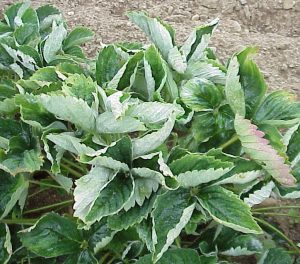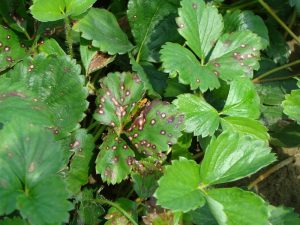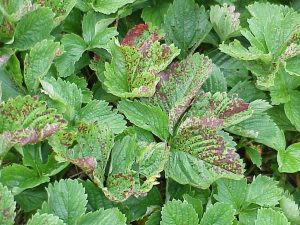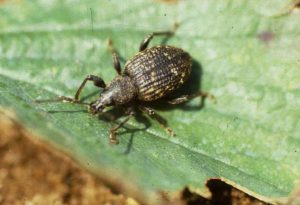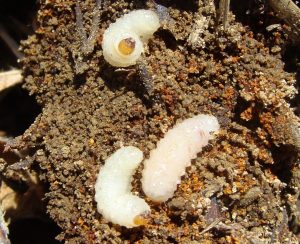Strawberry IPM Newsletter No. 5- July 9, 2021
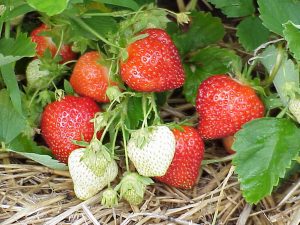
Strawberry IPM Newsletter No. 5- July 9, 2021
Click on photos to enlarge
RENOVATION AND WEED MANAGEMENT ISSUE
Get Your Strawberry Beds Ready for Next Year: Manage Pests in Day-Neutral Strawberries
The harvest season has come to a rapid and early close in most fields; as very-hot-dry June weather combined with a warm-dry spring resulted in an early start to harvest in many fields that condensed the picking season overall. The dry weather was undoubtedly stressful for the plants, but it did provide many good (albeit hot) picking days for customers, who came out in good numbers. We are, of course, still dealing with the COVID-19 pandemic and trying to keep ourselves, our staff, and our customers as safe as possible while opening the fields and farm stands.
Pest pressure was relatively light in most fields. Dry weather reduced potential problems with gray mold, and judicious fungicide applications have kept infections to a minimum. Spider mites and cyclamen mites were noticed in many fields, but generally in low numbers. Tarnished plant bug numbers were higher than we’ve seen in the past few years, but emergence was late, so they only threatened late ripening varieties where they were found. Flower thrips were also prevalent in strawberry blossoms in many fields. These can cause bronzing and cracking of berries when present in high numbers, but only one field I scouted had any visible injury.
Now that harvest is coming to an end, it’s time to get your plants ready for the next crop. Renovation of your beds should begin soon after harvest to allow the plants as much time as possible to re-establish and form healthy flower buds for next year. Follow the recommended renovation steps listed below for matted row strawberries.
STRAWBERRY BED RENOVATION REVIEW
Bed renovation should begin as soon after harvest as possible. The earlier the beds get renovated, the more time runner plants have to develop, which means larger crowns and more flower buds for next year. Early renovation also improves weed management by tilling in many weeds before they go to seed, and can help with insect, mite and foliar disease control by interfering with life cycles at a critical stage of development. The first step in the bed renovation process is to determine which beds should be carried over for another year and which should be plowed down and put into a crop rotation. Beds that did not suffer much from winter injury, had good production and a good plant stand with no major weed, insect, or disease problems should be carried over for another year. Beds that do not meet these criteria should be plowed down and seeded to a suitable cover crop to reduce weed, insect and disease problems that have developed, and to increase soil organic matter content. Ideally, beds that are plowed down should be rotated out of strawberries for at least three years. If properly managed, crop rotation will greatly reduce pest problems and improve the vigor and longevity of strawberry beds without the need for soil fumigation.
Renovating a strawberry bed is basically a thinning process to promote healthy new growth that can support a good crop next spring. While some parts of the following renovation scheme may be modified for individual situations, all beds should undergo the following steps once harvest is complete.
- Broadleaf weed control: If perennial broadleaf weeds such as dandelion, shepherd’s purse, daisy or goldenrod are a problem and/or a high population of annual broadleaf weeds such as lambsquarters, sorrel or pigweed are present, hand-pull as many as possible, especially within the plant rows, and/or apply 2,4-D amine (Formula 40®), or clopyralid (Spur®).
-
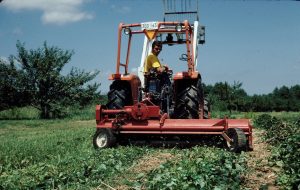
Mowing Strawberry Leaves, photo by David Handley Leaf mowing: Four to five days following the 2,4-D application (or immediately if 2,4-D was not applied) mow off the leaves of the strawberries about 1 ½ inches above the crowns. If the planting is weak or drought stressed, it is recommended that this step of the renovation process be skipped.
- Fertilization: Apply 40 to 60 pounds of actual nitrogen per acre (use the higher rate on sandy soils and fields where growth has been weak). Phosphorus and potassium applications should be made according to soil test recommendations. Soil testing kits and information are available from your County Cooperative Extension Office.
- Plant thinning: For the single matted row system, strawberry plant rows should not be any wider than 24 inches. After mowing off the leaves, till the sides of the rows to narrow the beds back to a width of 12 to 18 inches. Use the wider setting for varieties that tend to throw few runners or any fields experiencing drought stress. Set the tiller so that it incorporates the mowed leaves and spreads about one inch of soil over the remaining crowns at the same time. This will reduce leaf disease and mite problems, and help stimulate new root growth on the remaining plants.
- Pre-emergent weed control: To control annual weeds, apply terbacil (Sinbar® 80WP) according to label directions (2 to 6 oz. per acre). Be sure to follow all label precautions. To avoid plant injury, do not use terbacil if you do not intend to mow off the leaves. Napropamide (Devrinol®) or DCPA (Dacthal®), or Satellite HydroCap® may be used as an alternative to terbacil at this time. If you are not using herbicides, regular cultivation, before weeds are more than 2” tall, will be needed throughout the summer.
- Subsoiling: Soil compaction caused by tractor and picker traffic in the field can cause soil drainage problems and interfere with good root development. Using a subsoiling blade between the rows will break up compacted layers of soil and improve water infiltration. Subsoiling is best done late in the renovation sequence to prevent interference from straw and crop residues.
-
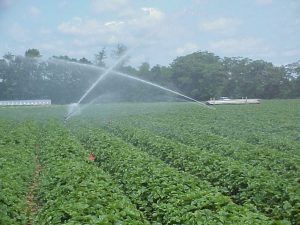
Strawberry Irrigation, photo by David Handley Irrigation: To encourage rapid plant growth and get the most out of fertilizers and herbicides, irrigate the beds regularly. Strawberries will grow best if they receive 1 ½ inches of water per week during the growing season.
Don’t forget your plants once these renovation steps are completed. Check the strawberry fields regularly during the summer for pest problems. Finding and managing problems early can prevent major problems next spring. Pay close attention to the following items.
Nutrition:
Following the application of 40 to 60 pounds of actual nitrogen at renovation, another 20 pounds of nitrogen should be applied in mid- to late-August to stimulate flower bud development. One way to determine the nutrient status of strawberry plants during the summer is to have a leaf tissue analysis done. Tissue analysis offers a view of what is happening within the plant, and can spot any nutrient deficiencies. In combination with regular soil tests, tissue analysis will provide a complete picture of a field’s fertilizer needs.
For more information about tissue analysis contact:
Analytical Lab, 5722 Deering Hall, Rm. 407, University of Maine, Orono, ME 04469-5722, Telephone: 581.2945, web page
Continue to scout for and manage disease, insect and weed problems as they arise. Some of the more common issues to be alert for during the summer are listed below.
Diseases:
Foliar diseases should be monitored in your fields by regularly examining leaves. Foliar diseases are more likely to become apparent under wet weather conditions. The most common summer diseases are powdery mildew, leaf spot and leaf scorch. Fungicides available for these diseases include captan, Topsin-M®, Cabrio®, and Pristine®. See the New England Small Fruit Management Guide for detailed descriptions of these diseases and their management.
- Powdery Mildew, photo by David Handley
- Leaf Spot; photo by David Handley
- Leaf Scorch; photo by David Handley
Black root rot is a disease complex which can be brought on by a combination of factors, including nematodes, soil fungi (Rhizoctonia, Pythium), herbicide carryover, and soil compaction. Plants become weak and may wilt and die. Roots on affected plants are black and poorly developed. This tends to be a problem in fields that have been in strawberries for many seasons, and in fields that have been stressed in other ways, such as winter injury. Rotating fields to crops other than strawberries for at least three years is an important management strategy for black root rot. Improving soil drainage and breaking up hardpans in the soil may also help. Pre-plant root dips with azoxystrobin (Abound®) may also reduce incidence of black root rot.
Insects:
If black vine weevils or strawberry root weevils are a problem in a strawberry field that you would like to carry over, bifenthrin (Brigade®, Bifenture®) can be applied when adult feeding is noticed (usually until late July–early August). Look for notching along the leaf edges and the presence of the black or brown snout beetles. Applications should be made at night when these insects are active, and the highest rate of the insecticide should be used. For control of the grubs, a soil drench of Platinum® (thiamethoxam) insecticide should be applied during the fall and/or early spring when the grubs are active in the soil. This product has a 50-day pre-harvest interval and may also be used as a pre-plant or planting treatment for root weevils. Parasitic nematodes such as Heterorhabditis bacteriophora or Steinernema feltiae can also be applied to provide control of root weevil grubs in late August. Nematodes require specialized handling and application. Contact us or talk with one of the suppliers for more details. See the New England Small Fruit Management Guide for sources.
- Black Vine Weevil; photo by David Handley
- Strawberry Root Weevil Grub; photo by David Handley

White grubs are the larvae of several species of scarab beetles, including June beetles, rose chafers, Japanese beetles, Asiatic garden beetles and European chafers. The beetles lay their eggs in June and July and the grubs feed on the roots of strawberries from July through mid-September. Affected plants will be stunted and wilted and may die during dry periods. Pulling up plants reveals that roots have been chewed off about an inch below the soil line. Sifting through the soil below the plants may reveal the whitish crescent-shaped grubs which can range in size from 3/8 inch to almost 1 ½ inches long, with six legs near the head and a swollen rear-end. The two most effective periods to treat plantings for grubs are in the spring prior to when they pupate (May) and in the late summer when the next generation is actively feeding (late August). Materials should be applied with plenty of water to moist soil to be sure they reach the root zone. Materials currently registered for control of grubs include Platinum® and Admire Pro®. Parasitic nematodes can also provide control of grubs and should be applied with similar timing. Nematodes are very sensitive to ultraviolet light and dehydration and must be applied with lots of water. See the New England Small Fruit Management Guide for sources of parasitic nematodes.
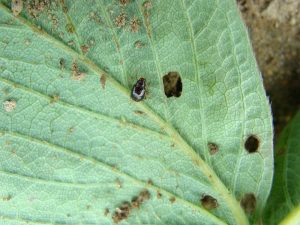
Strawberry rootworm (NOT root weevil) is a small (1/8″) dark brown to black beetle that feeds on strawberry foliage, causing it to look skeletonized. The small larvae feed on strawberry roots, further weakening the plant. Adult feeding damage on the leaves usually occurs in the spring and again in late July through August. Heavy rootworm feeding weakens strawberry plants so control is warranted when injury is noticed. Sevin® is registered for control of rootworm after harvest.

Keep a lookout for potato leafhoppers; the injury has been common in new strawberry beds this year. The potato leafhopper does not overwinter in Maine, but must fly in from southern states. These small, bullet-shaped insects feed on plant sap from the undersides of leaves, causing the leaves to become curled, stunted and yellow-streaked. Symptoms are often first noticed in new strawberry plantings, and may look like herbicide damage. Leafhoppers will also infest older plantings and a variety of vegetables, flowers and fruit crops. To scout for leafhoppers, brush the leaves of the plants with your hand. The small, whitish adults can be seen flying off the plant. Examine the underside of some injured leaves. Look for small, light green leafhopper nymphs. They are about 1/16 inch long. When touched, they will crawl sideways in a crab-like manner. Controls for potato leafhoppers include Assail®, malathion, carbaryl or Provado®.
Mites:
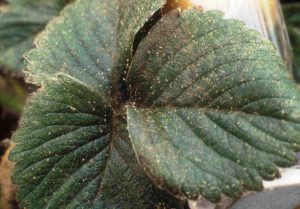
Two-spotted spider mites can increase significantly during the summer, especially in hot-dry weather. Continue to take leaf samples for spider mites throughout the summer. If more than 25% of a 60-leaf sample has mites, controls should be applied. Summer is an ideal time to use predatory mites to control pest mites, because they prefer warm temperatures, and there is less chance of an insecticide spray that might kill them. Amblyseius fallacis can provide good control of two-spotted spider mites when they are released at a rate of about 10,000 mites per acre. Predator mite releases should only be made after a spider mite infestation has been found in the field. Releasing predators into a clean field will often result in them dying, due to a lack of food. See the New England Small Fruit Management Guide for sources of predatory mites.
Cyclamen mites:
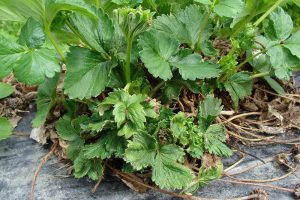
Cyclamen mite injury was observed in several fields this spring. If your field has cyclamen mite symptoms, summer is a good time to control them. After mowing off the leaves, access to the crowns where the mites reside is greatly improved. Plants showing weak growth and yellow-crinkled leaves may be infested with cyclamen mite. These mites are very small and reside down in the crown of the strawberry plant feeding on the developing leaves. They are very hard to see, even with magnification. The miticide Portal® can be effective, but must be applied with lots of water (200 gallons.) to be sure that the material is carried down into the crowns.
Weeds:
Weeds often become a big problem during the summer because they are forgotten among all the other demands on our time and because of limited control options. However, the importance of good weed management should not be underestimated. Keeping weeds under control this summer will help prevent future infestations. Here’s a summary of weed control options for established strawberry beds:
- Cultivation: Following renovation, cultivation between strawberry rows can provide effective temporary control of annual weeds. Several types of cultivators are available which will work well in strawberry beds. Cultivators can also be used to help sweep runners into the plant rows.
- DCPA (Dacthal®): A pre-emergent herbicide used in the early spring, late fall or after renovation. It offers good short-term control of some annual broadleaf weeds and grasses. It is weak on ragweed, galinsoga, smartweed, shepherd’s purse and mustard. Its action will be improved if worked into the soil by irrigation or light cultivation, and it tends to work best in lighter, warmer soils. This may be used as an alternative to terbacil or napropamide when there is a high risk of plant injury from those products.
- Napropamide (Devrinol®): This pre-emergent herbicide provides good control of annual grasses, volunteer grains and some broadleaf weeds. It is typically applied just before mulching in the fall. Split applications have become popular due to the loss of other pre-emergent herbicides, e.g. half maximum rate application after renovation or in late summer after desired daughter plants have rooted, and a second half rate application once the strawberry plants are dormant. Napropamide should be activated by irrigation, rainfall or light cultivation within 24 hours of application. Repeated long-term use of this material, i.e. with no crop rotation, may eventually result in poor daughter plant establishment, due to rooting inhibition.
- Terbacil (Sinbar®): An effective pre-emergent herbicide with some post-emergent activity, which should be applied at renovation time – after mowing and tilling the beds, but before new growth begins. A second application can be made in late fall, after the plants are dormant. No more than 6 oz. may be applied in a single application, and no more than 8 oz. may be applied in one season. An example of one season’s use could be 5 oz. applied at renovation and 3 oz. applied in the late fall, the latter in addition to napropamide or DCPA. Terbacil can cause injury to strawberry plants. It is important to determine appropriate rates for each location.
- Clopyralid (Spur®): Has both pre-emergent and post emergent activity on many weeds. One application per crop per year following harvest to emerged weeds. Apply uniformly in a minimum of 10 gallons of water per acre. Do not tank mix with other herbicides. Offers control of clover, dandelion and thistle.
- Sethoxydim (Poast®): A post-emergent herbicide for control of actively growing grasses. It will not control broadleaf weeds. It should not be applied when grasses are under stress, e.g. drought, or on unusually hot, humid days. Do not use sethoxydim within 6 weeks of terbacil (Sinbar®) applications, to avoid leaf injury. Sethoxydim should be used in combination with a crop oil concentrate. Do not tank mix with 2, 4-D. A second application is often needed for control of perennial grasses.
- Clethodim (Arrow®, Prism®, Select®): A post-emergent herbicide, similar in activity to Poastâ, for control of actively growing grasses. It will not control broadleaf weeds. It should not be applied when grasses are under stress, e.g. drought, or on unusually hot, humid days. Clethodim should be used in combination with a crop oil concentrate.
- Paraquat (Gramoxone Inteon®): A contact herbicide for post-emergent control of most annual weeds and suppression of many perennial weeds. Paraquat will injure or kill strawberries, so applications are made between rows only, with a sprayer shielded to protect the strawberries. It should be used in combination with a nonionic surfactant. Paraquat should not be applied within 21 days of harvest or more than three times in one season.
- Pelargonic Acid (Scythe®): A contact herbicide for post-emergent control of most annual weeds and suppression of many perennial weeds. Scythe® will injure or kill strawberries, so applications are made only between rows, with a sprayer shielded to protect the strawberries. This product has no residual soil activity. It has a strong, unpleasant odor.
- 2,4-D Amine (Formula 40®, Amine 4): A post-emergent herbicide effective on most broadleaf perennial weeds. It will not control grasses, nor offer any pre-emergent control. 2,4-D should be applied immediately after harvest is complete if emerging broadleaf weeds are a problem. After application, the bed should be left undisturbed for three to five days, before mowing the leaves off the plants. This allows time for the material to be taken in by the weeds. This material can also be used when the plants are dormant (late fall or early spring) to control winter annuals and biennials. Fall applications may result in injury to the strawberries if the plants are not completely dormant. Do not tank mix 2,4-D with sethoxydim (Poast®).
- Flumloxazin (Chateau®): A pre-emergent herbicide for control of broadleaf weeds, including dandelion and shepherd’s purse. For use in the fall when plants are dormant for control of weeds the following spring.
- Pendimethalin (Prowl H20®, Satellite Hydrocap®): A pre-emergent herbicide that may be applied as a band with a shielded sprayer between the rows of strawberries. No weed control will be provided within the plant rows, and contact of this product on the strawberry plants will cause injury. May not be applied within 35 days of harvest. Satellite Hydrocap® may also be applied at renovation, but before new growth begins.
The use of herbicides alone rarely gives complete weed control. Some hand weeding will be necessary. To provide good weed control throughout the life of a strawberry bed, growers should concentrate on crop rotation and good preplant weed control.
PEST MANAGEMENT FOR DAY-NEUTRAL STRAWBERRIES
Most of the important pests that damage June-bearing varieties can be as much or more of a problem on day-neutral types. Because day-neutral strawberries will have buds, flowers and fruit all occurring at the same time, it is critical to pay close attention to the required number of days to harvest after a pesticide application, to be sure you can safely harvest ripe fruit while still protecting buds and blossoms. Some of the more important pests are listed below, along with currently recommended pesticides and days to harvest as stated on current labels.

Spotted wing drosophila (Drosophila suzukii) is a concern for day-neutral strawberries, fall raspberries and blueberries. This insect lays its eggs on fruit before it ripens, resulting in fruit that is contaminated with small white maggots just as it is ready to pick. Infested fruit quickly rots and has no shelf life. This insect can complete a generation in under two weeks, with each adult female laying hundreds of eggs, so millions of flies infest a field soon after the arrival of just a few. Frequently repeated insecticide sprays (1 to 2 per week) may be needed to prevent infestations once the insect is present in a field. Spotted winged drosophila can successfully overwinter here, although it may not build up to damaging levels until late in the summer. Products that provide good control of drosophila on strawberries include Radiant®, Brigade®, Danitol®, Exirel®, malathion and Assail®. Keeping fields clean of over-ripe and rotten fruit will also help reduce the incidence of this insect. For more information on identifying spotted wing drosophila and updates on populations around the state, visit our SWD blog
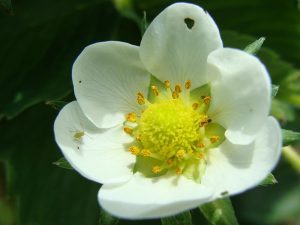
Tarnished plant bug:
This is one of the most prevalent and persistent pests of day-neutral strawberries, because summer flowering coincides with peak populations of this insect. Adult and nymph stages feed on the flowers and developing fruit, causing them to have seedy ends and other malformations. Regular insecticide applications are often required to keep the damage in check. Scout the flower clusters for adults and nymphs often to determine if controls are necessary. Insecticide products for tarnished plant bug include:
| Product | Days to Harvest |
| Brigade® | 0 |
| Pyganic® | 0 |
| Assail® | 1 |
| Dibrom® | 1 |
| Rimon® | 1 |
| malathion | 3 |
Two-spotted spider mites:
Mites can become a problem during the summer when the growing conditions are warm and dry. In addition to infesting the leaves, mites can move onto the fruit, reducing marketability. Plants that are drought-stressed, over fertilized with nitrogen, or prone to dust covering, e.g. growing beside a dirt road, are especially prone to mite infestation. Predatory mites can be an effective means to control spider mites and keep them in check over the season. Releases should only be made when spider mites are present in the field to provide the predators with a source of food. Most of the products labeled for controlling spider mites will also kill predatory mites; so, do not use these products after predators have been released. Scout for mites often during the season by examining the undersides of the leaves. Control is warranted if more than 25% of leaves examined have mites.
| Product | Days to Harvest
|
| Brigade® | 0
|
| Zeal® | 1
|
| Vendex® | 1
|
| Acramite® | 1
|
| Portal® | 1
|
| Danitol® | 2
|
| Agri-Mek® | 3
|
| Oberon® | 3
|
| Savey® | 3
|
Potato leafhoppers, sap beetles, thrips and spittlebugs may also become problems on day-neutral strawberries, but are less frequently observed than tarnished plant bugs and spider mites. Recommendations for these insects can be found in the current edition of the New England Small Fruit Management Guide
Foliar and fruit diseases also need to be managed on day-neutral strawberries, and should be controlled in much the same way as they are for June-bearing varieties. Most of the fungicide products labeled to control gray mold, powdery mildew, leaf spot and leaf scorch have either zero or one day to harvest, so protecting blossoms at the same time as fruit is near harvest should not be a problem; but be sure to check labels carefully and schedule your sprays and harvests accordingly. Anthracnose fruit rot can be especially troublesome for day-neutral strawberries, because it grows well under warm conditions and spreads by splashing water, which is encouraged on plastic mulch. Fungicides registered for control of anthracnose include Cabrio®, Abound®, Pristine® and Switch®, all of which have zero days to harvest restriction.
Visit the New England Small Fruit Management Guide online and for more detailed pest information UMass Extension Fruit Program
Sincerely,
David T. Handley
Vegetable and Small Fruit Specialist
Highmoor Farm Pest Management Unit
P.O. Box 179 17 Godfrey Dr.
Monmouth, ME 04259 Orono, ME 04473
207.933.2100 1.800.287.0279
Where brand names are used it is for the reader’s information. No endorsement is implied nor is any discrimination intended against products with similar ingredients. Always consult product labels for rates, application instructions and safety precautions. Users of these products assume all associated risks.
The University of Maine is an equal opportunity/affirmative action institution.

